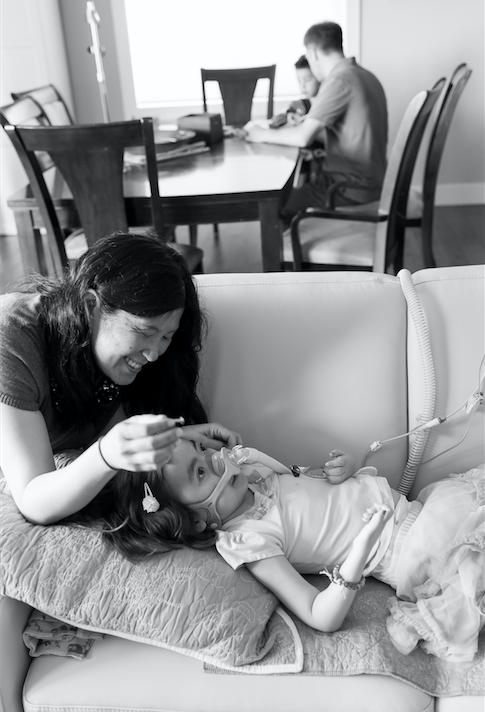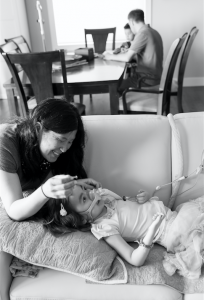6/24/2020
·Enable high contrast reading
Going there: Peeking at End of Life

 Envisioning a child’s death is essentially impossible. Wretched and mind-stopping, the prospect may feel like an abandonment of the role as parent, protector, caregiver. Michelle captures the darkly surreal nature of it: “My greatest fear was that Julianna was going to die, period. When the fear of something is so great that you can’t talk about it, even to yourself, it churns around in that subconscious space where it grows and takes on all different kinds of forms. It’s hard to describe how horrible it is. You think you can’t possibly face it—you’d rather die than face it, but your child needs you.”
Envisioning a child’s death is essentially impossible. Wretched and mind-stopping, the prospect may feel like an abandonment of the role as parent, protector, caregiver. Michelle captures the darkly surreal nature of it: “My greatest fear was that Julianna was going to die, period. When the fear of something is so great that you can’t talk about it, even to yourself, it churns around in that subconscious space where it grows and takes on all different kinds of forms. It’s hard to describe how horrible it is. You think you can’t possibly face it—you’d rather die than face it, but your child needs you.”
When my nephew Hayden passed away five months prior to my daughter Cameron’s death from the same disease, my husband was there in person to support his brother. Thus he was able to describe for me Hayden’s final days and end of life itself. Charlie’s first-hand experience deactivated the worst of my anxiety and dread during the remainder of Cameron’s life. This experience, particular to my family, was one of the seeds for Courageous Parents Network: the understanding that it’s helpful to address our questions head on, and to look for guidance and answers from others who have been there, too.
Such questions as What does it look like? Can I keep my child comfortable? What are the signs that they are dying? What sort of help will I need? What about feeding and hydration at end of life? Where do I want them to be when they die – home or hospital? What about their siblings? What will I do with the body? These questions are healthy, natural and an indication of the parents’ desire to do the best they can for their child all the way through the end (and beyond) in the context of a situation over which they otherwise have no control. My nephew Hayden’s death taught me that.
CPN’s new unit: “Preparing for End of Life” includes information and guidance, directly but gently offered,designed to help families prepare for the loss of their child. It is born of the experience of families who have been there and are willing to share what it was like, what mattered most, what they wished they’d known.
We recognize that one can never be truly prepared, but CPN believes we can help parents feel as equipped as possible by giving them information.
Now, what about information for providers? What do parents want providers to understand about what it was like for them emotionally, so as to help providers best support and accompany families during this dreadfully difficult time? CPN asked some of its bereaved parents three questions: what was your greatest fear about your child’s death, what do you wish you’d known; what helped you most? The following themes emerged in their responses (in no particular order). We share them here in the hopes that the CPN community finds them helpful.
Fear that their child would suffer. This is true for all parents, but was emphasized by parents who anticipated that their child would die at home with minimal medical support. “I had a lot of fear based around knowing Emerson was going to die, but not knowing at all how or when. I was afraid that whatever happened, I would be alone with her and unable to effectively manage the situation. And I was afraid that because of that, her death would be traumatic and she would suffer,” says Sarah.
Planning for “presence” in the face of uncertainty. Parents desperately want to have a sense for their child’s life expectancy, so that they can be “prepared” for the end. In many cases this is not possible. A child may also recover from near-death moments, making the ultimate moment difficult to recognize. Several parents noted that they struggled with this. Brenda’s son had come back multiple times from being terribly ill: “I wanted someone to say, ‘Brenda, Sam is dying…this is what dying looks like. Forget about everything else. Nothing else matters now. Just lay next to him, hold him and tell him you love him.’” Caryn notes that “the continual disconnect between the medical team’s problem-solving attitude and Robby’s obvious deterioration fueled confusion and anxiety.” Such a situation is especially unhelpful when the family’s goal is to support the wishes of the child. Caryn continues: “The persistent uncertainty created inherent conflict in how my son understood what was happening to him, and how we managed it together as a family. … The most important value we held as we were parenting our son in his last year, was to be honest and present with him, no matter what.”
The burden of decision-making. Parents wrestle with decision-making for the entire illness journey, and this is absolutely the case as they prepare for their child’s death. “My greatest fear is that I would break and not be able to see the decisions that needed to be made with a clear head,” says Jennifer. Oralea’s list is similar: “Will I have the strength to make the right decisions and put William’s needs in front of my own? How can I make end-of-life decisions when I know it means saying goodbye to my son?” Caryn stresses the importance of listening to the wishes of her teenage son as a compass: “As a young adult, Robby had the capacity to understand what was happening and strong opinions about what he wanted. And knowing that we did everything possible, in the way he needed us to, is what helps us even after he is gone.”
Survival of self. Multiple parents expressed awareness, and concern, that their grief had the potential to interfere with their child’s needs—or that the grief would be utterly consuming. “I feared for my life without him while focusing foremost on the relief of his suffering,” shares Kerri. Imagining the other side of the death can feel crippling. “How can I possibly live past that moment of his last breath?” Oralea remembers thinking. She sought out bereaved parents in the patient disease group connected to her son’s condition and notes: “Talking to parents who were three, five, ten years out from the time of their child’s death, and seeing that they were not broken and that they could laugh again and share memories of their child without being completely destroyed, gave me a sense of peace and hope that I could do the same.”
Respecting signals from the child’s body as a path forward. Against this backdrop, several parents felt that their child’s body knew what it needed to do. “I worried that there was more I could do, while learning that his body was in charge,” says Kerri. Oralea expresses it this way: “I feel he was ready and that it was he who made the ultimate decision that it was his time to leave us. I did not have to choose it and I did not have to explicitly make many of the decisions that I had dreaded. None of my worries that I had had through the years as I thought about end-of-life came to fruition. If I had been able to know that and trust that, maybe I would have had a greater sense of calmness.”
The invitation and space to talk about the possibility the child will die. No one wants to talk about this possibility, but it can be liberating and empowering to do so. Kerri says: “With access to both hospital and community-based palliative care, there were many people I could turn to about my fears, worries and hopes for Kai’s life. I contemplated and expressed my thoughts about the possibility of his death from early in diagnosis. While I was hopeful during that time, I spoke often of the dark thoughts in the back of my mind.” Michelle’s version of this is especially poignant: “I worried about Julianna’s death for years, and I probably knew that she was going to die for at least six months before I could face it. This was the worst time of my life, even worse than her actual death. Admitting it was so incredibly painful, but once I did, it was so much better. In my case, it happened after I finally got myself to a therapist. There was an immense sense of relief, then an odd calmness: I faced it, and it didn’t kill me.”
Sadness at leaving the hospital without their child. “It is very hard to just walk out. I wish that I had understood what the process is in the hospital after a child dies. Many of the things that happened were unnerving and I think if I had known I could have prepared,” remembers Jennifer. Kerri’s adds, “The only regret I have contemplated has been not staying longer with his body after death. I did not know at the time that there as a process of cleaning and dressing the body. I only found this out later in hearing from other parents who participated in this process. I am not sure I would have wanted to do these things myself, but it was hard finding out only after that it is something I could have participated in. There are times I have wished I had stayed longer with his body; however, I recognize that no amount of time would have ever felt enough.”
Impact of the palliative care provider(s). All of these issues exist in that space where palliative care can play a pivotal role. As noted, Kerri’s ability to voice her worries and concerns to palliative care providers is what helped her most. Similarly, Sarah says, “The things that helped me most were having an extremely involved and supportive primary care pediatrician and access to a high quality pediatric palliative care pediatrician, as well as other palliative care providers at the hospital. When I was in those settings I felt very safe and supported. We had big picture conversations about goals of care, what we hoped for Emerson both in terms of living and dying. This allowed us to make thoughtful decisions that we’ve never regretted or second guessed. I can’t overstate how huge this was.” Jennifer’s son Ben’s palliative care doctor was instrumental in the hospital at the end: “The single most valued resource was our palliative care doctor. When I expressed fear over the rapid pace and my growing sense of being vulnerable and unsure of my decisions, in very concrete terms she reminded me of the things I could control… She gave me clear information on which I could base choices. She helped me find the language to talk with my other children, my spouse and myself.” (NOTE: Concern for siblings is chronic; accordingly, the unit includes resources for talking to and supporting the siblings.)
As with all aspects of serious illness and end of life, there is no one or right way to proceed or understand. By being aware of fellow parents’ experiences, parents may be better able to articulate what they are wrestling with, seek help if desired, plan if they wish, and, we hope, feel more confident to move forward with minimal regret toward maximal healing.
Find the Full Unit Preparing for End of Life here
The photo is of Michelle with her daughter Julianna.


